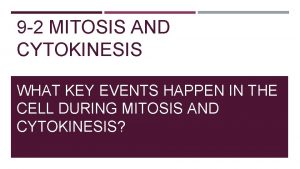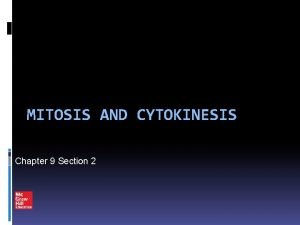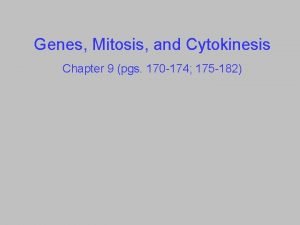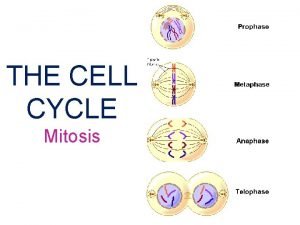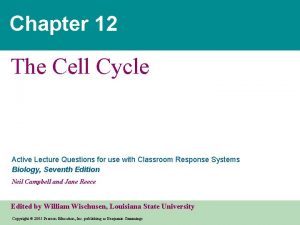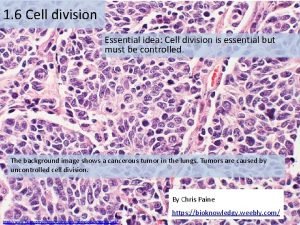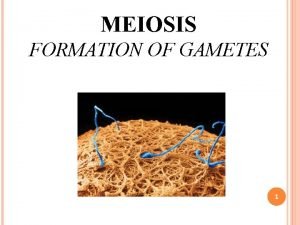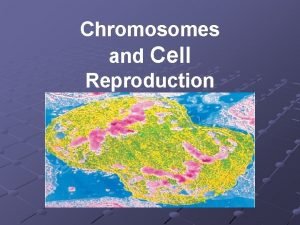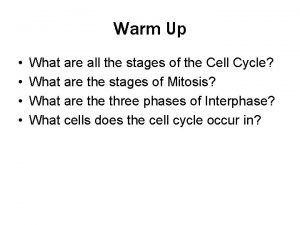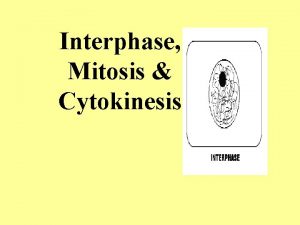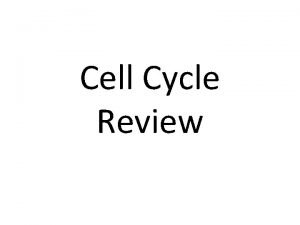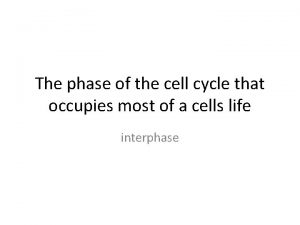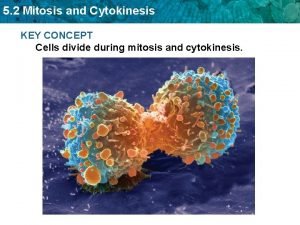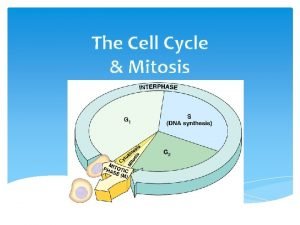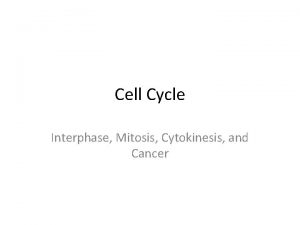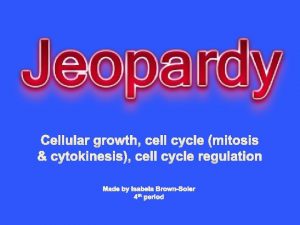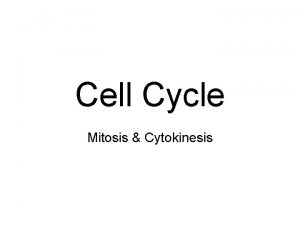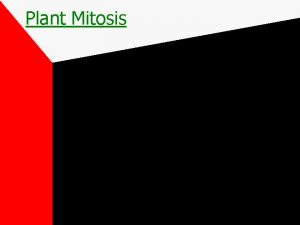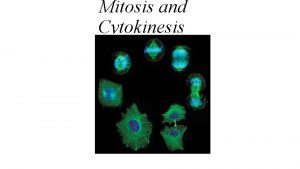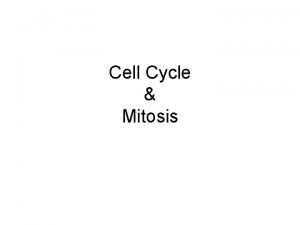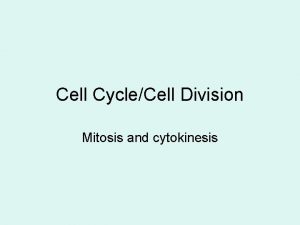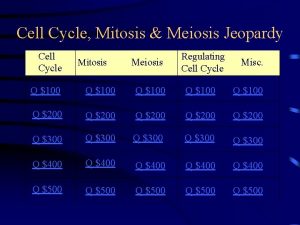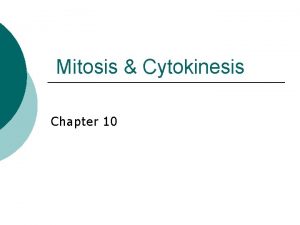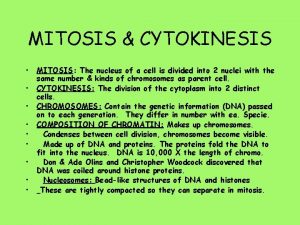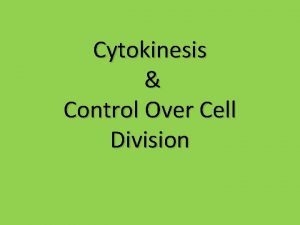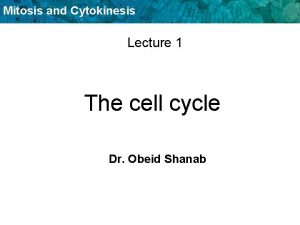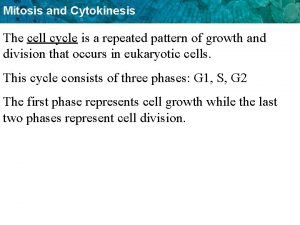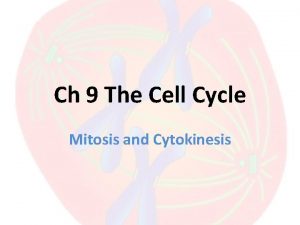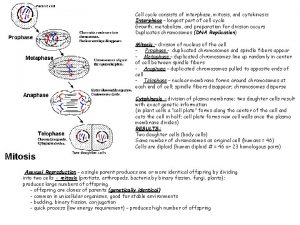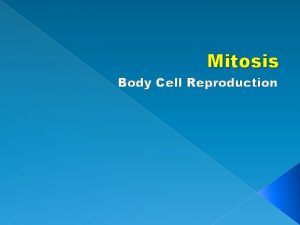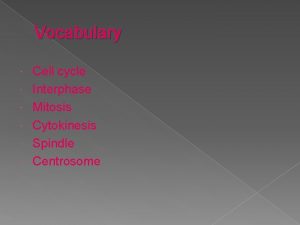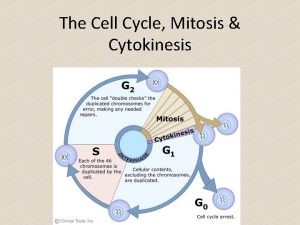The Cell Cycle Mitosis Cytokinesis and Cancer Mitosis





















- Slides: 21

The Cell Cycle: Mitosis, Cytokinesis and Cancer

Mitosis is. . . � 2 nd stage of the cell cycle (usually the shortest) �Results in 2 daughter nuclei ◦ Contain the same number/kinds of chromosomes

�Sister Chromatids: the DNA molecules that replicated during interphase join together to form chromosomes �Centromere: joins the sister chromatids

The Stages of Mitosis. . . 1. 2. 3. 4. 5. Early Prophase Late Prophase Metaphase Anaphase Telophase


1. Early Prophase Terms to know. . . �Spindle fibres: tiny tube like structures made of protein ◦ Controlled by centrioles �Centrioles: organelles that “organize” spindle fibres ◦ Move to opposite ends of the cell ◦ Not found in plant cells

�Chromosomes coil in “X” shapes and become visible under a light microscope �Nucleolus disappears and nuclear membrane breaks down �Spindle fibres form and stretch across cell

2. Late Prophase �Spindle fibres are completely formed �Chromosomes attach to spindle fibres at centromeres �Nuclear membrane completely disappears

3. Metaphase �Spindle fibres pull X-shape chromosomes into a straight line across the centre (equator) of the cell

4. Anaphase �Spindle fibres begin to shorten �Centromere is pulled apart, forcing sister chromatids to opposite ends of the cell �Separate sister chromatids now considered chromosomes

5. Telophase �Complete set of chromosomes at each end of cell �Spindle fibres begin to disappear �Nuclear membrane reforms around each set of chromosomes �Nucleolus appears in each nucleus Now that there are 2 nuclei in the cell, the cell can divide!


Cytokinesis is. . . �Final stage of the cell cycle �Separates the 2 nuclei into 2 daughter cells ◦ Daughter cells are identical to parent cells �Animal Cells: cell membrane pinches together to divide cell’s cytoplasm and organelles �Plant Cells: cell plate forms along entre of the cell to divide cell into 2 daughter cells


Checkpoints in the Cell Cycle �Checkpoints monitor the activities within a cell during the cycle �Special proteins send info to the nucleus, which decides if the cell is ready to divide �A cell will NOT divide if. . . ◦ There aren’t enough nutrients to support growth ◦ DNA has not been replicated ◦ DNA is damaged


The Cell Cycle and Cancer �Gene mutations could result in a faulty checkpoint protein ◦ RESULT: cell cycle control is lost! ◦ Ex. : cell could divide uncontrollably �Cancer: certain diseases that are caused by uncontrolled cell division

�Healthy/normal cells grow in a single layer and stop when told by neighbour cells �Cancer cells do NOT stop ◦ Form multiple layers tumours �Cancer cells have large, abnormal nuclei ◦ Checkpoints aren’t working, causing chromosomes to divide incorrectly



�Cancer cells attract blood vessels, which deliver nutrients �Cancer can spread if tumour cells break away and are carried by blood vessels to a new location �Cancer researchers are studying how the cancer cells mutate genes (producing non-functioning proteins) and how they can treat the disease
 Whats the process
Whats the process Cytokinesis
Cytokinesis Chapter 9 section 2 mitosis and cytokinesis
Chapter 9 section 2 mitosis and cytokinesis Cells cycle
Cells cycle The best conclusion concerning delta is that the cells
The best conclusion concerning delta is that the cells Mitosis and cell cycle terminology
Mitosis and cell cycle terminology Mitosis and meiosis concept map
Mitosis and meiosis concept map Cell cycle mitosis
Cell cycle mitosis Cell cycle and cell division
Cell cycle and cell division Cell cycle and cell division
Cell cycle and cell division 4 daughter cells
4 daughter cells Separate picture
Separate picture What are spindle fibers made of
What are spindle fibers made of Biology.arizona.edu/cell bio/activities/cell cycle/01.html
Biology.arizona.edu/cell bio/activities/cell cycle/01.html What is mitosis gone wild
What is mitosis gone wild What happens in cytokinesis
What happens in cytokinesis Dna scrunches up and chromosomes are first visible
Dna scrunches up and chromosomes are first visible Predict what would happen if cytokinesis was skipped
Predict what would happen if cytokinesis was skipped What occurs after cytokinesis is completed?
What occurs after cytokinesis is completed? Cytokinesis
Cytokinesis Cell cycle diagram
Cell cycle diagram Pmat mitosis
Pmat mitosis
